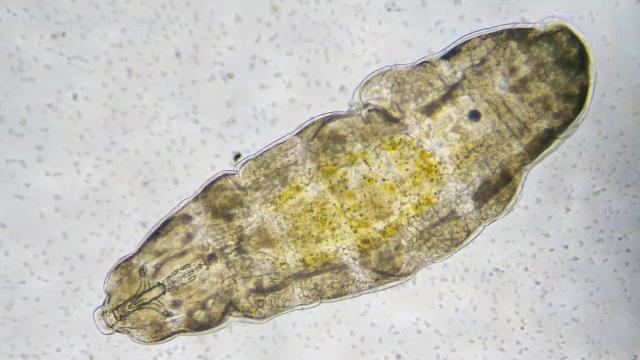Microscopic tardigrades are among the toughest animals on Earth, capable of withstanding freezing temperatures, the vacuum of space, and intense radiation. As new research shows, they’re even able to survive high-speed impacts — but only to a point.
New research in Astrobiology shows that tardigrades can survive impacts in excess of 2,607 km per hour (728 metres per second). That’s incredible, and we can now add this fun little anecdote to the seemingly endless list of things these resilient critters can withstand.
But — and this is a big but — tardigrades cannot survive impact speeds beyond around 3,219 km per hour (900 metres per second), in which pressures reach 1.14 gigapascals. This means it’s highly unlikely — but still not completely impossible — for these itty-bitty animals to hitch a ride on an asteroid and subsequently survive an impact on a planetary body.
And indeed, this was the very thing that the new study was trying to assess, namely the “ability of tardigrades to survive impact shocks in the kilometre per second and gigapascal range,” according to the study, led by Alejandra Traspas, a Ph.D. student at Queen Mary University of London. Because these speeds and pressures are typical of the impacts “that occur naturally in the Solar System,” the new paper serves as a test of the Panspermia Hypothesis — the unproven idea that alien microbes can kickstart life and evolution on an otherwise lifeless world.
For the experiment, Traspas, along with co-author Mark Burchell, took 20 tardigrades of the species Hypsibius dujardini and fed them a (potentially) last meal of mineral water and moss. The well-fed microbes were then put into hibernation — a frozen state in which their metabolism dropped to a mere 0.1% of normal. Groups of two to three individuals were put inside water-filled shafts that were in turn placed inside a nylon cylinder. A two-stage light gas gun was used to fire these cylinders, along with their hibernating passengers, at sand targets inside a vacuum chamber. Six shots were fired at speeds from 556 to 1,000 m/s, which the scientists measured with laser light stations.
Upon recovering the cylinders, Traspas and Burchell analysed the condition of the tardigrades to “discern whether they returned to a mobile [active] state.” A control group was also tested, in which 20 tardigrades were frozen, but not shot from a gun, and revived (all of them survived the resuscitation process).

Miraculously, some tardigrades survived, but “in the higher speed shots,” beyond 900 m/s and 1.14 GPa, “only fragments of tardigrades were recovered,” according to the study. These excessive speeds and pressures literally caused the microscopic animals to break apart, leading Traspas and Burchell to write: “Given that the results here suggest that peak shock pressures above 1.14 GPa will kill tardigrades, then it is likely that arrival of a tardigrade on Earth, for example by way of a meteorite impact, is not likely to be a viable means of a successful transfer even for such hardy organisms.”
This would seem to serve a heavy blow to the Panspermia Hypothesis, as meteorite impacts on Earth reach speeds of around 3,959 km per hour (1,100 m/s). But as the scientists argue, microbes attached to asteroids might sometimes experience low shock pressures. This could include events in which chunks of a planet are tossed to the surface of a nearby moon or cases in which microbes are tucked away inside a meteorite such that they’re not exposed to shocks above the survival limit, as the scientists speculate in the paper.
What’s more, this experiment was limited to tardigrades, and a single species at that. It’s conceivable that other microscopic organisms, including simple bacteria-like microbes (like these guys), might be capable of withstanding greater stressors. Simply put, the jury is still out on the Panspermia Hypothesis, even if it remains a fringe theory.
Interestingly, there’s a real-world implication to the new study. Back in 2019, Israel’s Beresheet probe — with a batch of tardigrades on board — accidentally crashed onto the lunar surface at speeds reaching 140 m/s, or 499 km per hour. That’s below the threshold of tardigrade destruction, leaving us wondering if these creatures are lying dormant on the surface of the Moon. I wouldn’t put it past them.
